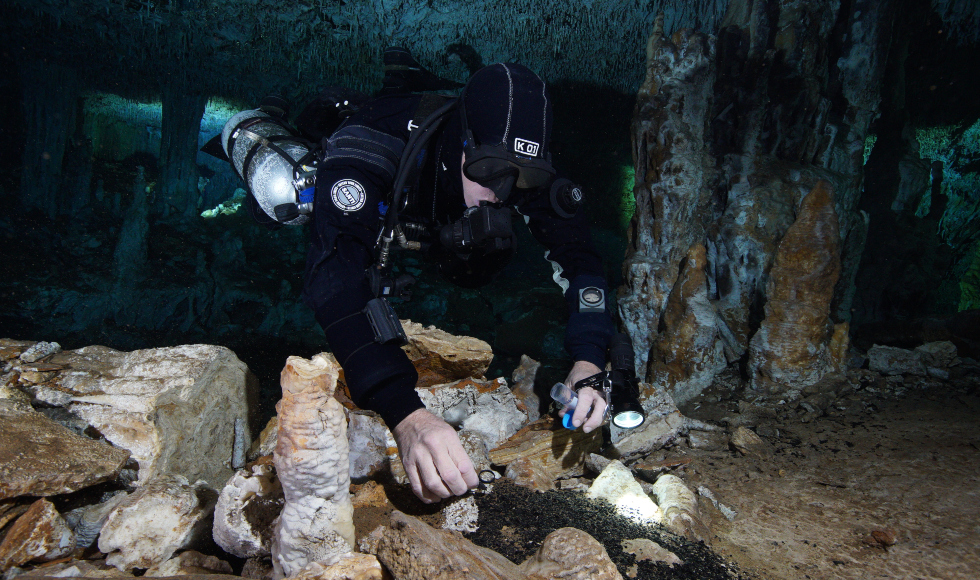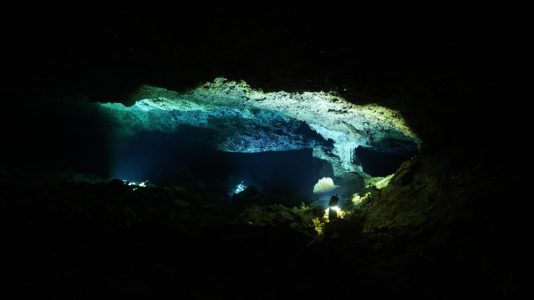Researchers find first evidence of ancient mining activity deep within underwater Yucatán cave system

Photo courtesy of CINDAQ.ORG
BY Michelle Donovan
July 3, 2020
The stunning underwater caves of Mexico’s Yucatán Peninsula have yielded the first clear evidence suggesting early humans ventured deep underground into a labyrinth of treacherous tunnels, to prospect and mine red ochre, a highly valued mineral pigment used widely by North America’s earliest inhabitants.
The elaborate cave passages, located along the eastern coastline of Quintana Roo, were dry and accessible more than ten thousand years ago but as sea levels rose, most of the caves flooded, creating the ideal conditions to preserve human activities.
Skeletal remains are scattered throughout and for two decades scientists have debated why Paleoindians would have navigated such a complex, dark and dangerous environment with tight passages, low ceilings, sharp stalactites and stalagmites.

A team of international researchers and expert divers, including those from McMaster University, The University of Missouri Research Reactor, Centro Investigador del Sistema Acuífero do Q Roo (CINDAQ), and Instituto Nacional de Antropología e Historia, discovered remarkably preserved mining sites which include ochre extraction beds and pits, digging tools, shattered and piled flowstone debris, navigational markers and hearths. In some areas, the ceiling is still visibly blackened, likely by the soot of the small fires.
Their findings are reported today in the journal Science Advances.
“The underwater caves are like a time capsule,” says Ed Reinhardt, an expert diver and professor in McMaster’s School of Earth, Environment and Society who collected, analyzed and dated samples from the caves. “There is clear evidence of ochre mining which would have taken place thousands of years ago.”
Researchers suggest ochre was of great, if not critical importance to the culture and lives of Paleoindians, given the sophistication needed to accomplish large-scale extraction which would have required the efforts of many.
“What is remarkable is not only the preservation of the mining activity, but also the age and duration of it. We rarely, if ever, get to observe such clear evidence of ochre pigment mining of Paleoindian age in North America, so to get to explore and interpret this is an incredible opportunity for us. Our study reinforces the notion that ochre has long been an important material throughout human history,” says Brandi MacDonald, professor at the Archaeometry Laboratory at the University of Missouri.
Red ochre is the most commonly identified inorganic paint used throughout history. Considered to be a key component of human evolutionary development and behavioral complexity, ochre minerals were collected for use in rock paintings, mortuary practices, painted objects and personal adornment.
Researchers speculate it may have been used as an antiseptic, sunscreen, or even a repellent for pests such as ticks or lice.
“We have no doubt that there is so much more out there just waiting to be found and understood,” says Sam Meacham, cave exploration researcher and founder of CINDAQ. “We hope that these amazing discoveries of ancient human activities preserved in these waters from so long ago will draw attention to the threats these waters face from human activity now. Ultimately the real treasure within the caves is what flows through them that allows people and wildlife to thrive.”

There are nearly 2,000 km of known underwater cave systems in the Yucatan Peninsula which scientists are certain will yield new and important discoveries.


